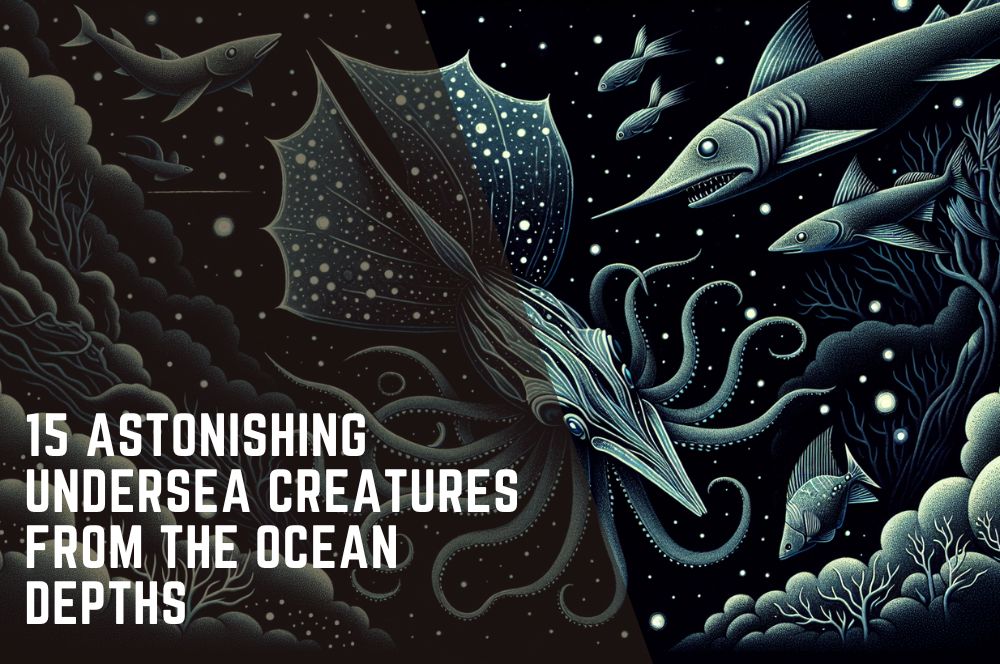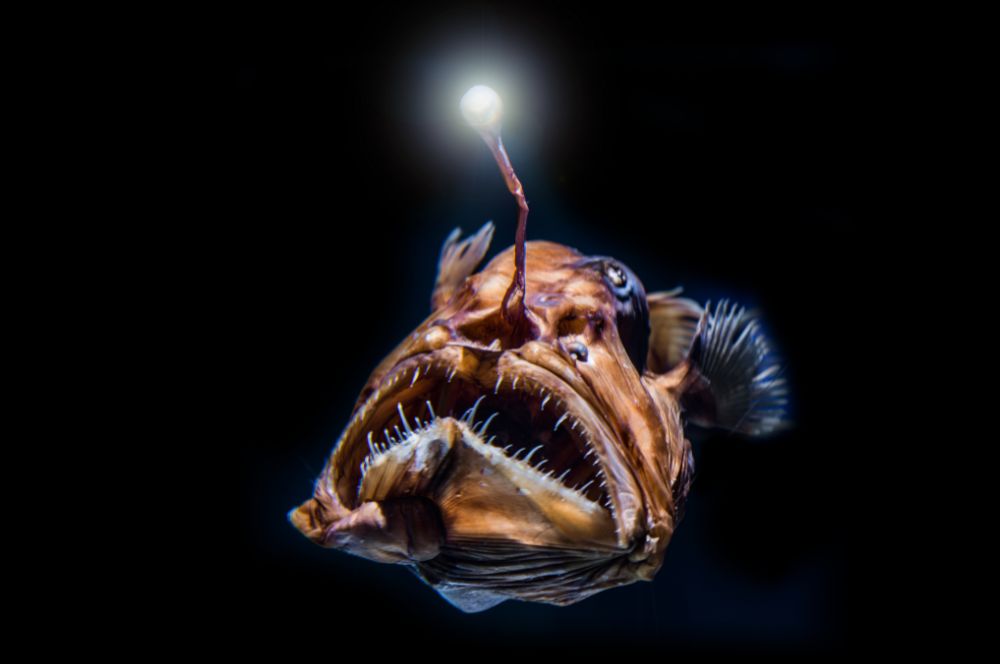You have 0 product(s) in your cart.
Abyss Scuba Diving
Explore The Depths: 15 Astonishing Undersea Creatures Revealed

Discover 15 Astonishing Undersea Creatures from the Ocean Depths
The ocean depths house an array of undersea creatures with remarkable traits. From bioluminescent allure to giants lurking in the abyss, their world is as alien as it is fascinating. This article reveals 15 such species, each with unique adaptations that allow them to conquer the challenges of their underwater domain.
Key Takeaways
-
The ocean’s twilight zone is bustling with unique life forms like the vampire squid, all adapted to the dim light and pressure of the depths.
-
Creatures in the deep sea have evolved amazing survival tactics, like bioluminescence for communication and camouflage to evade predators or capture prey.
-
Exploration technology advancements like ROVs and satellite communication are pushing the boundaries of how we study and understand the deep sea’s mysterious ecosystems.
Exploring the Ocean's Twilight Zone

Imagine a world where the sun’s embrace weakens and the blue fades to black. This is the twilight zone of the ocean, the mesopelagic realm that exists between 200 to 1,000 meters below the sea’s surface. Here, faint sunlight filters through the water, casting a dim glow on a bustling community of marine life. In this dusky environment, a diverse array of sea creatures, from the whimsical dumbo octopus to the elusive whiplash squid, call this vast expanse home. Among them, the vampire squid stands as an emblem of adaptation, its cloaklike webbing and dark coloration allowing it to melt into the shadows, a phantom in the deep. But life here is not static; it pulses with the rhythm of the ocean as organisms engage in vertical migrations, ascending and descending through the water column in tune with the shifting light.
The twilight zone is a place of perpetual dusk, where life has evolved in extraordinary ways to harness the sparse light. It’s where the deep sea begins its descent into the unknown, a prelude to the profound darkness that lies below. As we explore this enigmatic zone, we’ll uncover the ways in which its inhabitants have become masters of survival in a world where the sunlight’s touch is a distant memory.

The Enigma of Bioluminescence
In the ink-black waters of the twilight zone, bioluminescence is the spark that illuminates the darkness. This incredible ability to produce one’s own light is not just for show; it’s an essential tool for communication, hunting, and survival. Picture the sea creatures here, like the enigmatic sea angels and the stealthy dragonfish, using their own light to cut through the dark, crafting a language of luminescence that speaks volumes in the silence of the deep. Their eyes, often large and complex, have adapted to capture every photon, allowing them to detect the faintest glimmers of life in the depths.
Bioluminescence is more than nature’s nightlight; it’s a beacon that guides marine life through the otherwise impenetrable darkness. It’s the red light that beckons a mate, the silly string that confuses a predator, and the lure that draws in unsuspecting prey. In a world where the sun’s rays falter, bioluminescence stands as a testament to the adaptability and ingenuity of deep sea creatures.
Masters of Camouflage
The art of hiding is taken to new depths in the Twilight Zone, where creatures have evolved to become masters of camouflage. Recent research from the Queensland Brain Institute has peeled back the curtain on how species like the squid vanish into their surroundings with a flicker. Cephalopods, the chameleons of the sea, exhibit a mesmerising dance of colours across their skin. Their unique ability to display different colours on their dorsal and ventral sides creates an optical illusion, rendering them almost invisible to predators and prey alike.
This mastery of disguise is a testament to the evolutionary arms race that plays out in the dark depths. In a habitat where being seen often means being eaten, the ability to blend seamlessly into the environment is not just a trick up one’s sleeve; it’s the difference between life and death.
Predators of the Deep
The twilight zone, while hauntingly beautiful, is not for the faint of heart. It is home to some of the ocean’s most formidable predators, creatures that have honed their hunting skills to perfection in the deep. The thread-tail fish, with its binocular-like eyes, is a sharpshooter in the perpetual gloom, spotting potential prey with deadly accuracy. Meanwhile, the boxer snipe eel sweeps its long jaws through the murky waters, ensnaring crustaceans in its fine-toothed grasp.
These predators of the deep embody the essence of adaptation, evolving specialized hunting techniques to thrive where others would falter. Their existence is a delicate balance, a perpetual hunt in the vast, dark ocean that is both their home and hunting ground.
Giants of the Abyss

The abyss is a realm of giants, where the phenomenon of deep-sea gigantism brings forth creatures of mythic proportions. Some of these colossal creatures include:
-
The colossal squid, a behemoth of the deep, stretches up to 14 meters, its tentacles and large teeth a testament to its might.
-
The giant squid, its elusive kin, reaches lengths that rival the tallest trees on land.
-
Giant tube worms thrive in the most extreme conditions.
-
The deepwater stingray, with its impressive span, is also found in the depths.
-
The Stygiomedusa jellyfish, whose tentacles could engulf a small boat.
These giants of the abyss remind us that size is a survival tool in the deep sea, where the pressure is crushing and the darkness is unyielding. In these profound depths, to be large is often to be unseen, to be a ruler in a kingdom where sunlight never reaches, and the mysteries are as vast as the creatures themselves.
The Peculiar Life Cycle of Deep Sea Fish
Deep-sea fish lead lives that are anything but ordinary, much like the sea cucumber, sea pig, and sea stars. Take the seadevil anglerfish, a creature whose bizarre reproductive behaviour has intrigued scientists for years. Here, the smaller males become permanent fixtures on the larger females, serving as a ready supply of sperm in exchange for sustenance—a symbiotic relationship as strange as it is efficient. This peculiar life cycle, beginning in shallower waters and descending into the abyss as they mature, is a journey of transformation.
As these fish adapt to the crushing pressure of the depths, they shed their buoyancy and develop unique adaptations such as hydrofoils for stabilisation. Some even possess the astounding ability to distend their jaws and stomach, allowing them to consume prey much larger than themselves, a feat that highlights the unforgiving nature of their environment.
Residents of the Ocean Floor

The ocean floor is a landscape of extremes, where the pressure is immense, and the temperature plummets. Yet, life flourishes here, as exemplified by the Japanese spider crab, whose long, spindly legs span the length of a car. This benthic world is also home to the mysterious basket stars, the plump sea pigs, and the otherworldly zombie worms, each species a marvel of adaptation to the abyssal plain’s harsh conditions.
This relatively level habitat, stretching out far below the ocean’s surface, supports a wide array of marine life, each creature perfectly attuned to its enigmatic surroundings. From the eyeless crustaceans to the Benthocodon jellyfish, the residents of the ocean floor are a testament to the resilience and ingenuity of life in the face of adversity, even as they dwell far from the ocean surface, which is another term for the ocean’s surface.
Coral Reefs: Cities Beneath the Sea
Coral reefs are the bustling metropolises of the ocean, vibrant ecosystems teeming with life. Known as the rainforests of the sea, these underwater cities are pivotal to marine biodiversity, providing shelter, food, and spawning grounds for about a quarter of all marine fish species. Deep-sea corals, including deep sea coral, far from the sunlit shallows, still manage to thrive by capturing tiny organisms from the surrounding currents, drawing energy and nutrients from the water itself.
But these essential habitats face threats on all fronts, from the warming waters that induce coral bleaching to the pollution and overfishing that chip away at their foundations. The plight of coral reefs is a clarion call for conservation, a reminder of the fragile beauty that lies beneath the waves and the urgent need to protect it.
Ingenious Adaptations to Extreme Environments
The deep sea, also known as the deep ocean, is an unforgiving place, a world of extreme pressure, cold, and darkness. Yet, its inhabitants, including various deep-sea animals, have developed an array of ingenious adaptations that enable them to not just survive but thrive. The vampire squid, for example, boasts blood that binds oxygen with remarkable efficiency, a trait that allows it to inhabit the oxygen minimum zone without succumbing to the sparse availability of this vital molecule. Deep-sea fish have tuned their vision to the dark environment, with enhancements like the protein rhodopsin aiding in their ability to see in near-total darkness.
Life near hydrothermal vents presents another set of challenges, where temperatures can soar to lethal levels. Yet, here, too, life abounds, with heat-resistant organisms relying on symbiotic bacteria to harness the energy from the earth itself. These creatures, living in conditions that once seemed impossible for life, underscore the remarkable adaptability of the denizens of the deep.

Alien-like Inhabitants of the Mariana Trench
The Mariana Trench, the deepest part of our oceans, is a place of alien landscapes and even more alien inhabitants. At depths reaching 11,000 meters in the hadalpelagic zone, life takes on forms that defy the imagination. The snailfish, the trench’s deepest living fish, and the dumbo octopus, with its ear-like fins, are just two of the remarkable species that thrive in this high-pressure, low-temperature world.
These species, like the enigmatic goblin shark and the frilled shark, have evolved in isolation, developing characteristics perfectly suited to the immense pressures and frigid temperatures of their environment. They are the epitome of life’s capacity for adaptation, a reminder that even in the most inhospitable corners of the Earth, life finds a way.
The Great Migrators of the Ocean Depths
Every day, as the sun sets and rises, the Pacific Ocean witnesses the greatest migration on Earth. Deep-sea creatures, from tiny crustaceans to larger animals like squid and fish, embark on a vertical journey from the depths to the surface and back again. This daily vertical migration involves an astonishing amount of biomass and is driven by the need to feed and avoid predators.
This movement involves various species and is not uniform across the board. Some creatures migrate at night to feed under the cover of darkness, while others follow a reverse or twilight pattern. These migrations are a dance of survival, one that is crucial to the balance of marine ecosystems.
Marine Snow: The Ocean's Food Supply
Descend into the deep, and you’ll find a world where food falls from above. Marine snow, a mix of dead organisms, fecal matter, and other detritus, drifts down from the ocean’s upper layers, providing a crucial food source for the creatures of the deep. This organic matter contributes to the composition of the sea floor’s ooze and plays a key role in carbon sequestration.
Some key facts about marine snow:
-
It is a mix of dead organisms, fecal matter, and other detritus.
-
It drifts down from the ocean’s upper layers.
-
It provides a crucial food source for deep-sea creatures.
-
It contributes to the composition of the sea floor’s ooze.
-
It plays a key role in carbon sequestration.
A staggering 815 million tons of marine snow reaches the abyss each year.
As this marine snow settles on the ocean floor, it becomes a feast for animals like the vampire squid and eel larvae, who rely on these pulses of nutrients for survival. This phenomenon is a reminder of the interconnectedness of ocean ecosystems, where the death of one creature provides life for another.
Deep Sea Squid: Masters of Disguise and Hunters
The deep-sea squid is a creature of mystery and mastery, an expert in the art of disguise and the craft of hunting. The vampire squid, with its light-producing photophores, can create dazzling displays to ward off predators or entice prey. This cephalopod can even eject a bioluminescent mucus, a defensive tactic that confounds would-be attackers.
But the squid’s mastery does not end there. Some, like the telescope octopus, are transparent, floating vertically in the water to blend into their surroundings. These adaptations are not just for show; they are critical for survival in the deep, where every advantage counts in the hunt for food.

The Role of Ocean Currents in Deep Sea Life
Ocean currents are the lifeblood of the deep sea, shaping the distribution and survival of its inhabitants. These moving bodies of water, warm and cold, mix and churn, influencing the breeding patterns and success of marine species. The gyres that these currents create impact local ecosystems, affecting everything from food acquisition to the reproductive capabilities of deep-sea creatures.
As we unravel the role of these currents, it becomes clear that they are more than just the ocean’s conveyor belts; they are a driving force behind the diversity and abundance of life in the deep.
Technologies Pushing the Boundaries of Ocean Exploration
As we delve deeper into the ocean’s mysteries, cutting-edge technologies are our eyes and hands in the abyss. The shift from manned submersibles to autonomous and remotely operated vehicles (ROVs) has revolutionized our capacity to explore the ocean depths. Equipped with sophisticated tools like sonar, water column samplers, and coring devices, these modern explorers are extending our reach further than ever before, allowing us to monitor, sample, and map previously unreachable environments.
Advancements in remote sensing and satellite communication are bringing real-time data to scientists worldwide, fostering collaboration and expanding our collective knowledge of the deep. The Nautilus Expedition is a prime example of how these technologies come together, enabling researchers across the globe to work synchronously in uncovering the ocean’s secrets.
Summary
Our journey through the ocean’s depths has revealed a world of astonishing diversity and resilience. From the bioluminescent hunters of the twilight zone to the colossal giants of the abyss, each creature we’ve encountered tells a story of adaptation and survival. The technologies at our disposal are pushing the boundaries of what’s possible, allowing us to peer deeper into the ocean’s mysteries. As we continue to explore these uncharted waters, let us remember the importance of preserving this final frontier, for it is not only a bastion of biodiversity but also a critical component of our planet’s health and future.
Frequently Asked Questions
What is the largest undersea creature?
The largest undersea creature is the blue whale, which can grow up to 100 feet long and weigh upwards of 200 tons. It is not only the largest animal to live on Earth today, but also the largest animal to have ever existed.
What is marine snow, and why is it important?
Marine snow is important because it serves as a vital food source for deep-sea creatures and plays a crucial role in the ocean's carbon cycle, helping sequester carbon and contributing to the ocean floor's sediment.
How do deep-sea creatures adapt to the extreme pressure and darkness?
Deep-sea creatures have evolved specialized adaptations such as enhanced vision and heat-resistant features to survive the extreme pressure and darkness of their environment. These help them efficiently bind oxygen, reduce skeletal structures, and thrive near hydrothermal vents.
What is the significance of the daily vertical migration in the ocean?
The daily vertical migration in the ocean is the largest synchronized movement of biomass on Earth, playing a critical role in the balance of marine ecosystems by allowing deep-sea creatures to feed and avoid predators. It involves a variety of species and is crucial for maintaining the health of the ocean.
Why do some deep-sea animals exhibit gigantism?
Some deep-sea animals exhibit gigantism as an adaptation to the harsh conditions of their environment, including cold temperatures, scarce food, and high pressure, which can be better dealt with through larger size.
Recent Posts






